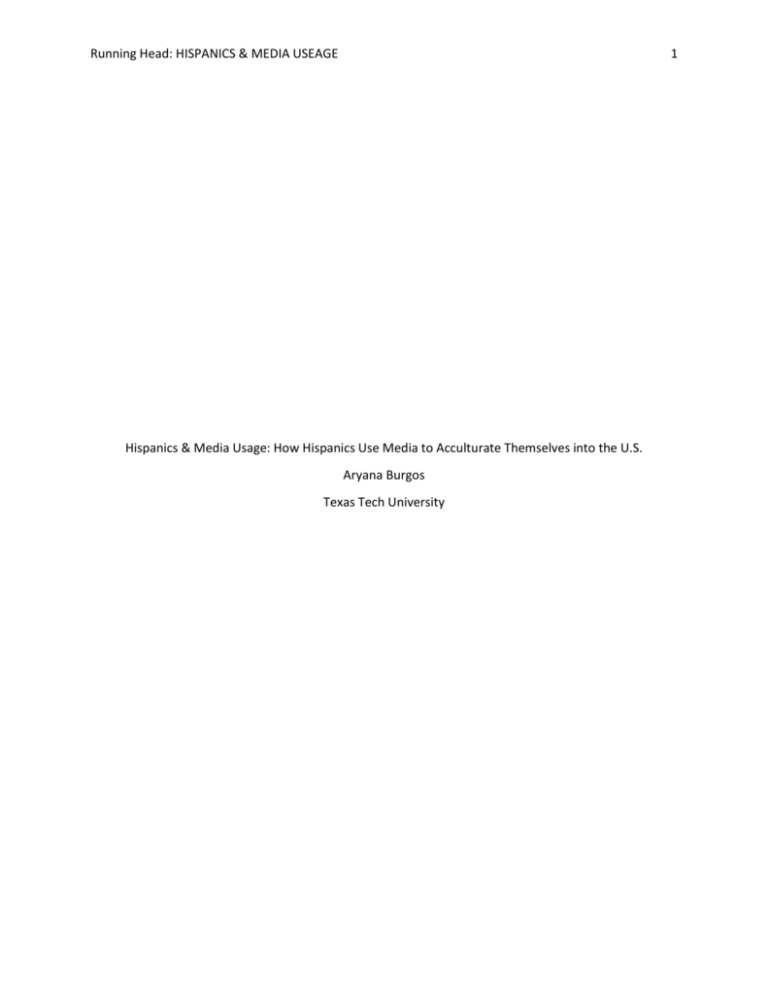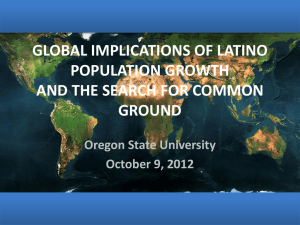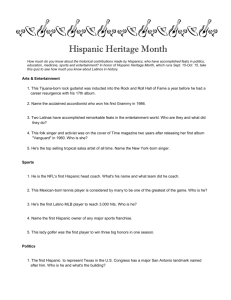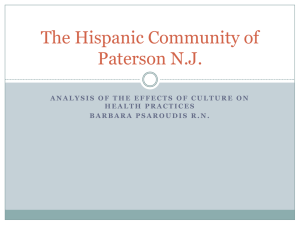Running Head: HISPANICS & MEDIA USEAGE Hispanics & Media
advertisement

Running Head: HISPANICS & MEDIA USEAGE 1 Hispanics & Media Usage: How Hispanics Use Media to Acculturate Themselves into the U.S. Aryana Burgos Texas Tech University Running Head: HISPANICS & MEDIA USEAGE 2 Immigration has an immense influence on how the United States constructs its classroom systems as well as the workforce and politics. The Hispanic population is currently the largest minority within the United States and it is predicted that Hispanics will be the majority race by the year 2050. In order to understand the Hispanic culture impact, this paper will examine the relationship between the Hispanic culture and their usage of social media to acculturate them into mainstream American society. In the first article, Dalisay (2012) defines acculturation as “a complex and multidimensional process in which immigrants retain aspects of their native culture while they acquire the host society’s culture through adopting its attitudes, norms, values and behaviors” (Dalisay, 2012, p. 149). Contrast that idea with the definition of assimilation, which “assumes that immigrants will discard their native culture when they adopt their host society’s culture” (Dalisay, 2012, p. 149). Princeton University developed a ‘new immigrant survey’ to evaluate the relationship between immigrants’ media use by three indicators of acculturation: current English proficiency, preference to use English in social interactions and basic American political knowledge. The main question of Princeton University’s ‘new immigrant survey’ was “how are pre and post immigrant uses of native language media associated with current (a) English proficiency, (b) preferences to use English in interactions and (c) American political knowledge” (Dalisay, 2012, p. 151). The participants of the survey were either “new arrival immigrants (i.e., those who had recently arrived to the United States with immigration documents from foreign countries) or adjustee immigrants (i.e., those already living in the U.S. with non-immigrant visa or illegal aliens but eventually became legal immigrants)” (Dalisay, 2012, 151). The 4,356 participants were randomized into three subgroups: group one was asked “how often they watched TV, group two was asked how often they listened to radio and group three was asked how often they read newspapers and magazines” (Dalisay, 2012, p. 151). The study showed that as immigrants became acculturated to America, their uses of American media increased while their usage of native media decreased. The Running Head: HISPANICS & MEDIA USEAGE 3 survey findings support the usage of English media as being associated with higher English proficiency and greater use of English in interactions. In the second article, Li & Tsai (2015) studied “how using social media might strengthen or weaken people’s tendency toward certain cultural value systems” (Li & Tsai, 2015, p. 204) and considered two languages, English and Spanish while examining their participants’ usages in six social media sites. The sites they chose were Facebook, YouTube, Wikipedia, WordPress, Second Life and World of Warcraft, which are categorized as social networks, content communities, collaborative projects and virtual social worlds (Li &Tsai, 2015). The “participants were allowed to engage in these social media platforms regardless of their physical location and were predicted to behave in a particular fashion, depending on the social platform implications made by other social users” (Li & Tsai, 2015, p. 204). The behaviors of these different ethnic individuals dictated how strong or weak their acculturation levels were in comparison to mainstream society (Li & Tsai, 2015). To “examine whether Hispanics with different demographic features acculturate into the American society differently, the authors analyzed: demographic variables, language proficiency in both English and Spanish, length of stay in America, inter-ethnic marriage, social networks built in home/host country and media usage (a) individual language skills (b) communication behavior (c) information seeking options (d) opportunities for social interactions” (Li & Tsai, 2015, p. 205). The findings of the social experiment proved that “English social media are frequently used among Hispanics, especially among females and younger generations” (Li & Tsai, 2015, p. 209), to acculturate themselves into American culture. The study also discovered “Hispanics from the U.S. generally use social media less frequently than those from other origins because the larger the amount of years lived in the U.S., there is a smaller usage of social media” (Li & Tsai, 2015, 209). This information allows us to conclude “social media is a useful tool for Hispanics to acculturate themselves into Running Head: HISPANICS & MEDIA USEAGE 4 American society” (Li & Tsai, 2015, p. 209). A key take away of this article is that future cultures will acculturate themselves into American society through social media (Li & Tsai, 2015). In the final article, Villarreal and Peterson (2006) “argues that there is a difference between being Hispanic and possessing Hispanic ethnicity through four segments classified as Strong Hispanics, ASymbolic Hispanics, Symbolic Hispanics, and Weak Hispanics” (Villarreal & Peterson, 2008, p. 179). Being Hispanic “is a binary demographic characteristic; one either self-identifies or does not identify as being Hispanic or is identified by others as being Hispanic” while Hispanicness “is a psychological construct that is the result of the extent to which one has been preconditioned within a Hispanic cultured environment” (Villarreal & Peterson, 2008, p. 179). Many of the participants made assumptions that Hispanics are grouped together by self-affiliation, surname, ancestral country and language preference. An earlier study in the early 1980’s brought to light “Hispanics who preferred Spanish-language radio were generally older, more likely to be married, less educated and more likely to speak Spanish at home contrasted with Hispanics who preferred English-language radio were generally younger, better educated, and less likely to be married” (Villarreal & Peterson, 2008, p. 181). The study itself was a phone survey composed of 762 Hispanic men and women aged 18-65 years old. The questionnaire consisted of a variety of demographic, product usage and attitude toward media items. The three pretests measured the strength of ethnic identity and familism on a Likert Scale from 1-5, the preferred language in which study participants watched TV and listened to radio, and preference to see ads in English. After discovering the strong correlation between self-identifying as a Hispanic and Hispanicness, it is vital for media influencers to understand the complexity of different languages and media behaviors to appropriately locate target audiences and efficiently deliver advertisements (Villarreal & Peterson, 2008). This paper examined the relationship between the Hispanic culture and their usage of social media to acculturate them into mainstream American society. Those within Hispanic culture who choose Running Head: HISPANICS & MEDIA USEAGE 5 to use English-language media found themselves more acculturated into mainstream American culture rather than Hispanics who consistently used Spanish-language media. The articles findings are important because Hispanic culture is the up and coming majority race, implying their heavy influence on the government and educational system. Running Head: HISPANICS & MEDIA USEAGE 6 References Dalisay (2012). Media use and acculturation of new immigrants in the U.S.. Communication Research Reports, 29 (2), 148-160. Li & Tsai, W-H S. (2015). Social media usage and acculturation: A test with Hispanics in the U.S. Computers in Human Behavior, 45 (April), 204-212. Villarreal & Peterson A. (2008). Hispanic ethnicity and media behavior. Journal of Advertising Research, 48 (2), 179-190.






